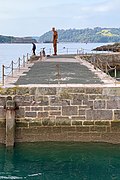| West Hoe | |
|---|---|
 | |
Location within Devon | |
| District | |
| Shire county | |
| Region | |
| Country | England |
| Sovereign state | United Kingdom |
| Post town | PLYMOUTH |
| Postcode district | PL1 3XX |
| Dialling code | 01752 |
| Police | Devon and Cornwall |
| Fire | Devon and Somerset |
| Ambulance | South Western |
West Hoe is an area of Plymouth in the English county of Devon.


